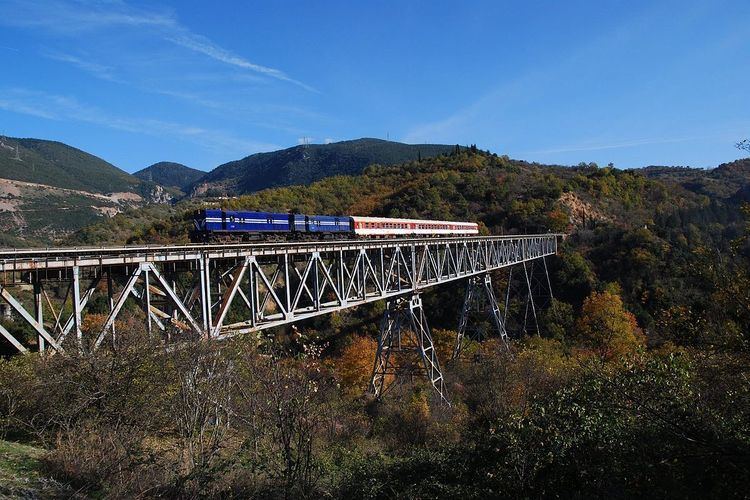 | ||
Hellenic State Railways or SEK (Greek: Σιδηρόδρομοι Ελληνικού Κράτους, Sidirodromi Ellinikou Kratous; Σ.Ε.Κ.) was a Greek public sector entity (legal person of public law, Greek: Ν.Π.Δ.Δ.) which was established in 1920 and operated most Greek railway lines until 1970.
Contents
History
The Hellenic State Railways took over the standard gauge railway line from Piraeus to Papapouli at the pre-1912 borders, the extension from Papapouli to Platy and most of the former Ottoman railway lines that were within the Greek borders after 1919. These lines were:
After World War II the Hellenic State Railways absorbed most other Greek railways, including:
Only Ellinikoi Ilektrikoi Sidirodromoi (E.I.S., later Athens-Piraeus Electric Railways), operator of Piraeus-Kifissia railway and Piraeus-Perama light railway, and the private mining and industrial lines remained independent.
The Hellenic State Railways existed until December 31, 1970. On the next day all railways in Greece with the exception of private industrial lines and E.I.S. were transferred to Hellenic Railways Organisation S.A., a state-owned corporation.
Network and other infrastructure
During this period very little expansion of the existing network took place, the most notable being:
A contract was signed in 1928 for a new line connecting Kalampaka to Kozani, but the project was abandoned in 1932 due to lack of funds.
The Greek railway system (both infrastructure and rolling stock) suffered serious damages during World War II (especially in 1943-1944) and did not become fully operational until 1950. However the viaduct of Achladokampos in Peloponnese, destroyed in 1944, was rebuilt only in 1974.
In 1960 the line from Larissa to Volos, of the former Thessaly Railways, was converted to standard gauge and was connected in Larissa with the line from Athens to Thessaloniki.
New station buildings were constructed in Thessaloniki (known as Thessaloniki New Passenger Station or ΝΕΣΘ) (1952), Larissa (1962), Lianokladi (1950), Sindos, Aiginio, Platamon, Florina, Edessa, Agras, Arnissa, Polykastron, Ptolemais and Kozani.
Rolling stock
Until 1962 the Hellenic State Railways used a variety of steam locomotives from various sources. Some of them belonged to the pre-1920 networks, a number were acquired as part of foreign aid programs after the war and a small number was procured.
Conversion to diesel traction began in the early 1960s. The first diesel locomotives were delivered in 1962 and included 30 Krupp Y60 shunters (Class A-101), 10 ALCo DL532B (Class A-201) and 10 ALCo DL500C (Class A-301). They were followed by classes A-221, A-321, A-351, A-401 and A-411 for the 1,435 mm (4 ft 8 1⁄2 in) standard gauge network and classes A-9101, A-9201 and A-9401 for the 1,000 mm (3 ft 3 3⁄8 in) metre gauge networks.
Diesel multiple units were first introduced in 1936 and became more common in the 1950s and 1960s. Steam locomotives were slowly phased out but were still in limited use in December 1970.
Steam locomotives
The following table shows steam locomotives acquired by the Hellenic State Railways between 1920 and 1969. They also continued to use an assortment of older types of locomotives inherited from the previous Greek and Ottoman railway companies.
Diesel multiple units
The Hellenic State Railways bought their first DMUs in 1936 and acquired larger numbers in the 1950s. Additional metre gauge multiple units were ihnerited from networks absorbed in SEK.
